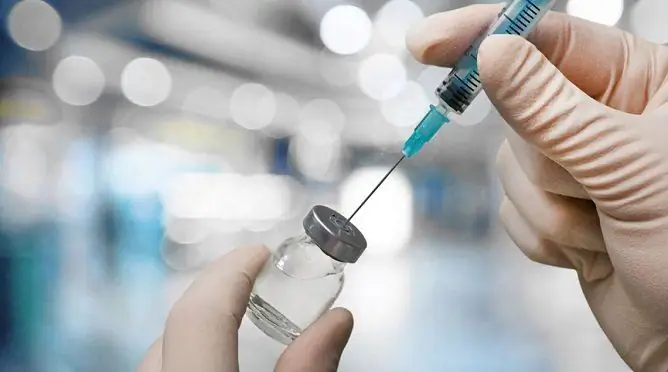- Author Rachel Wainwright [email protected].
- Public 2023-12-15 07:39.
- Last modified 2025-11-02 20:14.
POLIMILEX
POLIMILEX: instructions for use and reviews
- 1. Release form and composition
- 2. Pharmacological properties
- 3. Indications for use
- 4. Contraindications
- 5. Method of application and dosage
- 6. Side effects
- 7. Overdose
- 8. Special instructions
- 9. Application during pregnancy and lactation
- 10. Use in childhood
- 11. Drug interactions
- 12. Analogs
- 13. Terms and conditions of storage
- 14. Terms of dispensing from pharmacies
- 15. Reviews
- 16. Price in pharmacies
Latin name: Polimilex
ATX code: J07BF03
Active ingredient: inactivated polio virus type 1 (D-antigen), inactivated poliomyelitis virus type 2 (D-antigen), inactivated polio virus type 3 (D-antigen) [polio virus inactivated type 1 (D-antigen), polio virus inactivated type 2 (D-antigen), polio virus inactivated type 3 (D-antigen)]
Manufacturer: Nanolek LLC (Russia); Bilthoven Biologicals B. V. (Bilthoven Biologicals BV) (Netherlands)
Description and photo update: 2019-28-11
Prices in pharmacies: from 1680 rubles.
Buy

POLIMILEX is a medical immunobiological preparation, a vaccine for the prevention of poliomyelitis.
Release form and composition
The drug is available in the form of a suspension for intramuscular (i / m) and subcutaneous (s / c) administration: clear liquid from orange-yellow to orange-red [in glass bottles without color: 0.5 ml (1 dose), in a pack of cardboard 1 or 10 bottles or 360 bottles in a polymer container; 2.5 ml (5 doses), in a carton pack 1 or 10 bottles or in a polymer container 280 bottles and instructions for the use of POLIMILEX].
1 dose (0.5 ml) of inactivated poliomyelitis vaccine contains:
- active ingredients: inactivated poliomyelitis virus type 1 (D-antigen) - 40 units (unit of action), inactivated poliomyelitis virus type 2 (D-antigen) - 8 units, inactivated poliomyelitis virus type 3 (D-antigen) - 32 units;
- auxiliary components: 2-phenoxyethanol, formaldehyde, sodium phosphate buffer 0.1M [sodium phosphate disubstituted dihydrate and sodium phosphate monohydrate - to pH (acidity) 7], concentrated dilution liquid (potassium chloride, sodium chloride, magnesium sulfate heptahydrate, calcium chloride dihydrate, phenol red), water for injection.
Pharmacological properties
Pharmacodynamics
POLIMILEX is a vaccine against polio viruses of types 1, 2 and 3. It is obtained from three types of poliomyelitis viruses cultivated on the VERO cell line, then purified and inactivated with formaldehyde.
The immunological properties of the POLIMILEX vaccine allow the production of a significant amount of neutralizing antibodies to poliomyelitis viruses and immunological memory, starting from the second injection. Regardless of the general condition of the patient (including those with immunodeficiency, intestinal diseases, dystrophy), immunity to polio viruses is acquired after the third injection of the vaccine. With subsequent injections, immunity is enhanced and persists for at least 5 years after the first revaccination.
Seroconversion occurs in 95-100% of individuals after three doses.
Indications for use
The use of POLIMILEX is indicated for active immunization for the prevention of poliomyelitis.
Contraindications
Absolute:
- a severe reaction (an increase in body temperature above 40 ° C, hyperemia at the injection site over 8 cm in diameter, edema) or a complication of a previous injection of the drug;
- fever;
- acute infectious disease;
- chronic pathologies in the acute stage;
- established hypersensitivity to POLIMILEX components.
During pregnancy, the polio vaccine should only be used if the risk of infection is high.
POLIMILEX, instructions for use: method and dosage
Do not allow intravenous administration of the drug!
The vaccination room should be provided with anti-shock therapy, due to the existing risk of developing immediate allergic reactions.
The POLIMILEX vaccine should be administered by subcutaneous or intramuscular injection.
When taking a suspension, it is necessary to visually assess its appearance. If any deviations from the norm are found, it will be disposed of.
For children under the age of two, the vaccine is administered in the upper-outer region of the middle part of the thigh, for children over two years of age, and for adults, in the deltoid area.
Before injecting the drug, you should make sure that the needle is not in a blood vessel.
When using a vial with five doses of the drug, you must enter the date of opening in the appropriate field, which is located on the label of the vial. When the next dose is taken, a mark is put in the "Injected doses" column.
The recommended dosage for children and adults is 0.5 ml.
The use of POLIMILEX is carried out in accordance with the National Calendar of Preventive Vaccinations, which provides for vaccination at the age of 3; 4.5 and 6 months, revaccination - 18, 20 months and 14 years.
In children aged 3 and 4.5 months, an inactivated vaccine for the prevention of poliomyelitis is used for vaccination against poliomyelitis, for the third vaccination and subsequent revaccinations against poliomyelitis - a live vaccine for the prevention of poliomyelitis.
Children with human immunodeficiency virus (HIV) or those born to mothers with HIV infection, as well as children in children's homes, are vaccinated and then revaccinated according to age and the intervals between vaccinations and revaccinations, using inactivated vaccines to prevent poliomyelitis.
Side effects
According to the WHO (World Health Organization), adverse reactions are classified according to their frequency of development: very often - from 1/10; often - from 1/100 to 1/10; infrequently - from 1/1000 to 1/100; rarely - from 1/10 000 to 1/1000; extremely rare - from 1/10 000, including isolated cases. The basis for the formation of frequency categories were clinical studies of the drug and data obtained during post-registration observation.
The use of POLIMILEX can cause the development of the following undesirable reactions:
- from the respiratory system: in premature babies born less than 28 weeks of gestation - apnea;
- from the nervous system: very rarely - polyneuropathy;
- local and systemic reactions: rarely - soreness, swelling and / or redness at the injection site, fever;
- general disorders and reactions in infants aged 3 to 6 months: very often - anxiety, low-grade fever, irritability; often - crying, drowsiness, malaise, loss of appetite, soreness at the injection site, hyperemia or infiltration at the injection site, rash, cough.
Overdose
Overdose symptoms have not been established.
special instructions
Patients with fever, acute infectious or chronic illness should be vaccinated 14-28 days after recovery or during remission. For mild forms of acute respiratory viral infections or acute intestinal pathologies, the POLIMILEX vaccine is given immediately after the temperature has returned to normal.
Adverse reactions to the introduction of POLIMILEX are of a weak degree of severity and short-term (disappear within 1-3 days).
Immediately after vaccination, adolescents and adults may experience fainting, accompanied by nausea and vomiting. If similar conditions were observed during the previous administration of POLIMILEX, then such patients should take a sitting or lying position for the procedure.
Patients with congenital or acquired immune disorders may not have the expected immune response.
Immunization should not be delayed or considered contraindicated in premature infants born 28 weeks or earlier. The benefits of immunization in this category of children are high, but the primary course requires monitoring of respiration during the first 2-3 days after the administration of the drug, especially in the case of a history of signs of an immature respiratory system, due to the potential risk of developing apnea.
The frozen vaccine must be destroyed.
Influence on the ability to drive vehicles and complex mechanisms
The effect of POLIMILEX on the ability of adult patients to drive vehicles or complex mechanisms is not known.
Application during pregnancy and lactation
During pregnancy, the polio vaccine should only be used if the risk of infection is high. It was found that vaccination of women against poliomyelitis during gestation does not have a negative effect on the course of pregnancy and the health of the fetus or newborn.
During the period of breastfeeding, it is allowed to vaccinate POLIMILEX.
Pediatric use
The use of POLIMILEX is carried out in accordance with the National calendar of preventive vaccinations, which regulates the beginning of vaccination from 3 months of a child's life.
Drug interactions
POLIMILEX can be administered simultaneously with other vaccines, but in different parts of the body, with the exception of the tuberculosis vaccine (BCG) or the tuberculosis vaccine for sparing primary immunization (BCG-M).
For vaccination with POLIMILEX, you must use a separate syringe; you cannot mix it in one syringe with other vaccines or drugs.
Analogs
Analogs of POLIMILEX are BiVak polio (Polio oral vaccine, bivalent, live attenuated 1, 3 types), Poliomyelitis oral vaccine 1, 2 and 3 types, Imovax Polio, Poliorix.
Terms and conditions of storage
Keep out of the reach of children.
Store at temperatures from 2 to 8 ° C in a dark place, do not freeze.
The shelf life is 3 years.
Terms of dispensing from pharmacies
For hospitals.
Reviews about POLIMILEX
Reviews about POLIMILEX are controversial. This may be due to the child's individual reaction to the vaccine.
Price for POLIMILEX in pharmacies
The price of POLIMILEX for a package containing 1 bottle (2.5 ml) can range from 1300 to 1980 rubles.
POLIMILEX: prices in online pharmacies
|
Drug name Price Pharmacy |
|
Polimilex 0.5 ml / dose suspension for intramuscular and subcutaneous administration of 2.5 ml 1 pc. 1680 RUB Buy |

Anna Kozlova Medical journalist About the author
Education: Rostov State Medical University, specialty "General Medicine".
Information about the drug is generalized, provided for informational purposes only and does not replace the official instructions. Self-medication is hazardous to health!






